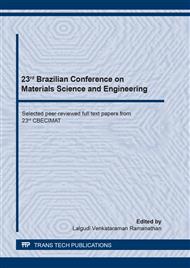[1]
F. Garavand, M. Rouhi, S.H. Razavi, I. Cacciotti, R. Mohammadi:. International Journal of Biological Macromolecules, 104, parte A, (2017) pp.687-707.
DOI: 10.1016/j.ijbiomac.2017.06.093
Google Scholar
[2]
J. Colivet, R.A. Carvalho: Industrial Crops and Products Vol. 95 (2017), p.599.
Google Scholar
[3]
A.A. Al-Hassan, M.H. Norziah: Food Hydrocolloids Vol. 26 (1) (2012), p.108.
Google Scholar
[4]
P. Zhang, Y. Zhao, Q, Shi: Carbohydr. Polym. Vol. 153 (2016), p.345.
Google Scholar
[5]
M. García, A.N.E Zaritzky: Starch/Staerke Vol 52 (2000), p.6.
Google Scholar
[6]
M. Ghasemlou, F. Khodaiyan, A. Oromiehie: Carbohydr. Polym. Vol 84 (2011), p.477.
Google Scholar
[7]
M. Chiumarelli, M.D. Hubinger: Food Hydrocolloids Vol. 28(1) (2012), p.59.
Google Scholar
[8]
ASTM E96/E96M-12. Standard test methods for water vapour transmission of materials. Annual Book of Standards (1993).
Google Scholar
[9]
C.M. Jaramillo, P.G. Seligra, S. Goyanes, C. Bernal, L. Famá: Starch/Stärke Vol. 67 (2015), p.780.
DOI: 10.1002/star.201500033
Google Scholar
[10]
L. Luchese, J.M. Frick, V.L. Patzer, J.C. Spada, I.C. Tessaro: Food Hydrocolloids Vol. 45 (2015), p.203.
DOI: 10.1016/j.foodhyd.2014.11.015
Google Scholar
[11]
ASTM D882-91. Standard test methods for tensile properties of thin plastic sheeting. Annual Book of Standards. (1996).
Google Scholar
[12]
F.M. Fakhouri, S.M. Martelli, T. Caon, J.I. Velasco, L.H.I. Mei: Postharvest Biology and Technology Vol. 109 (2015), p.57.
Google Scholar
[13]
J. Osés, M. Fabregat-Vázquez, R. Pedroza-Islas, S.A. Tomás, A. Cruzorea, J.I. Maté: Journal of Food Engineering Vol. 92(1) (2009) p.56.
DOI: 10.1016/j.jfoodeng.2008.10.029
Google Scholar
[14]
M.G.A. Vieira, M.A. Silva, L.O. Santos, M.M. Beppu: European Polymer Journal Vol. 47 (2011), p.254.
Google Scholar
[15]
K. Abdullah, K. Talip: Carbohydrate Polymers Vol. 104 (2014), p.50.
Google Scholar
[16]
C.C., Denardin, L.P.L Silva: Ciencia Rural Vol. 39 (3) (2009), p.945.
Google Scholar
[17]
L.C. Cossolino, A.H. Pereira, Módulos Elásticos: Visão Geral e Métodos de Caracterização. Informativo Técnico Científico. Disponível em: <http://www.atcp.com.br/imagens/produtos/ sonelastic/artigos/RT03-ATCP.pdf> Acesso em 03 de dezembro de (2018).
Google Scholar
[18]
A.L.M. Smits, P.H. Kruiskamp, J.J.G. Van Soest, J.F.G. Vliegenthart: NMR spectroscopy Vol. 53 (4) (2003), p.409.
Google Scholar


